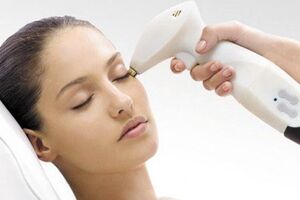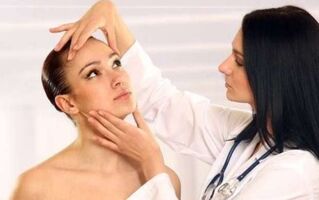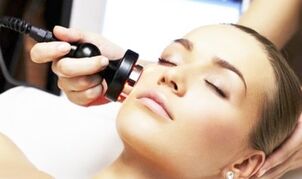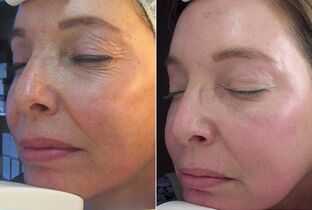For a long time, plastic surgery was the only way to rejuvenate. However, this method has many contraindications and is also associated with certain health risks, so not all can be solved with the help of surgery. Fortunately, modern aesthetic medicine offers many anti-aging treatments that are less dangerous. One of the worthy alternatives to plastic surgery is a laser facelift.
Fortunately, modern aesthetic medicine offers many anti-aging treatments that are less dangerous. One of the worthy alternatives to plastic surgery is a laser facelift.
What is it?
Laser lifting is a modern non-surgical way to combat age-related skin changes. This technique is aimed at improving the quality of the skin. It stimulates regenerative processes (cell renewal), improves blood circulation in areas with laser exposure, which helps smooth out wrinkles.During the procedure, natural collagen is actively produced, giving tissue elasticity. This is especially important for areas with delicate skin where different rejuvenation methods are unacceptable.
The difference between laser lifting and other methods of plastic surgery and facelift is that this procedure does not involve surgery. The operation is performed using special equipment for laser therapy. The light beam penetrates the skin and acts on weakened and dead cells.
Laser facelift can be performed for women and men aged 18 to 70 years. Most often, the need for this procedure arises after 30 years, when the first signs of skin aging appear.
Usually, cosmetologists prescribe laser lifting courses, as one session is not enough. Achieving the maximum effect is possible 3 months after the last performed procedure. With the right skin care, the rejuvenating effect can last for about three years.
Indications for the procedure
Laser lifting helps solve a large number of problems. The procedure is indicated for patients with the following problems:

- saggy skin in the eyelids
- expressions and age wrinkles;
- dark circles and bags under the eyes;
- pronounced nasolabial fold;
- acne ar;
- small scars;
- enlarged pores;
- unhealthy skin
- the presence of age spots;
- vascular networks;
- hanging double chin;
- wrinkles in the neck.
Contraindications
Laser lift is contraindicated in the presence of the following factors:
- acute inflammatory and infectious diseases;
- any oncological diseases
- chronic diseases
- various blood diseases;
- pregnancy and lactation
- HIV infection
- diabetes mellitus;
- mental disorders
- thyroid disease epilepsy;
- hepatitis;
- skin diseases of any kind
- bad blood clots.
Types of skin surface
In cosmetology practice, laser lifting is currently performed using two technologies: ablative and non-ablative. They differ in that each uses a different type of laser.
Ablative
Ablative is the most widely used laser lifting technology.The impact of the light beam is directed at the outer layer of the epidermis, which is in constant contact with the environment.
Under the influence of a laser, the dead skin layers gradually evaporate. The ablative facelift is traumatic, but it guarantees the result.
Non-ablative
This technique involves a laser beam that penetrates deep into the skin and stimulates the synthesis of collagen and elastin. The top layer of skin remains intact. This method of laser lifting helps to improve tissue tone, resulting in a facelift.
Unlike ablative tightening, which is also called "burning", the non-ablative technique is considered to be more gentle. The non-ablative lifting method can be used to affect sensitive skin areas - the eyelids and the area around the eyes.
This technology is not very popular as many cosmetologists doubt its effectiveness.
Preparing for the Procedure
Before the laser lift procedure, it is imperative to visit a beautician who assesses the general condition of the skin and draws a conclusion about the appropriateness of the operation.To reduce the risk of side effects, pass the following tests:
- general analysis of blood and urine
- X-ray of the chest;
- syphilis test
- HIV test;
- heart heart.
The doctor must also be aware of all the diseases that the patient has suffered.
About two weeks before the session, there are simple rules to follow:
- refuses to visit the bathhouse, sauna and solarium nor sunbathe in the sun;
- do not eat alcoholic beverages;
- drink antiviral drugs on a course (only as prescribed by a beautician).
It is not recommended to consume coffee and energy drinks on the day of the session.
How is facelift performed?
The technique of performing a laser lift is relatively simple:

- The patient puts a medical cap or bandage on his head to remove the hair and lies down on the couch.
- Next, the doctor prepares the skin: removes makeup residue and greasy secretions.
- Then apply a cooling gel to the face. For patients with very sensitive skin, anesthetic creams are used.
- The procedure is painful. For this reason, it is often performed under local or general anesthesia.
- During the session, the patient's eyes should be protected so that they wear dark glasses. Once you have completed the preparatory steps, you can start the laser lifting process.
- The physician runs a special device with a handpiece (manipulation) over the patient's face, paying particular attention to problem areas and preparing them carefully.
Different equipment is used depending on the procedure used. It differs in the technology of exposure and the depth of penetration of the light beam.
There are two types of lasers: cold and hot. For a facelift, a carbon dioxide, erbium or diode laser can be used.
- The carbon dioxide laser is the most powerful. Helps get rid of wrinkles and scars.
- Erbium effectively combats the first signs of aging. Mild on the surface of the skin.
- Deep skin rejuvenation is performed using a diode laser. The light beam can penetrate 5-50 mm inwards.
Ablative rejuvenation is performed with a carbon dioxide laser. Under the influence of heat, dead cells gradually evaporate, eventually leaving new and youthful skin.
Erbium and diode lasers are used for non-ablative facelift.The effect of the light beam is directed at the inner layer of the skin. Collagen production processes are triggered in the connective tissue, which contributes to tightening and rejuvenation of the skin.
At the end of the procedure, the beautician treats the patient's face with an antiseptic and then applies a soothing cream or mask.
Before and after photos
Further on the picture you can see the result before and after the procedure.

Rehabilitation
The length of the rehabilitation period depends on the technology of the procedure.The more intense the blow, the longer it takes to complete the restoration of the skin.
During rehabilitation, skin redness, swelling and hypersensitivity are common. These are permissible consequences of laser lifting and should not be alarming. After a few days, the symptoms disappear on their own.
After a laser lift, the skin needs careful care. The patient must carefully follow the doctor's recommendations and adhere to the following rules:
- Do not visit the pool, sauna, bathhouse and beach for two to three months;
- Be sure to use sunscreen when walking outside;
- Do not use decorative cosmetics until the skin is completely restored.
- try to touch your face with your hands as little as possible;
- excludes facial massage;
- give up bad habits;
- follow a healthy diet;
- drink plenty of fluids.
With proper care and compliance with the beautician's instructions, the results of a tightening can be seen already after seven days. The skin becomes firmer and healthier, wrinkles and scars disappear. The oval of the face gets a smooth shape and clear contours. Changes are usually not visible immediately after the procedure.
Complications
Laser facelift is considered a safe method of rejuvenation. During the procedure, there is no direct skin contact with the equipment, so the risk of infection with various diseases is minimized. Complications can occur in two cases: insufficient professionalism of the beautician and non-compliance with the patient's rules of care.
The following side effects are the most dangerous:
- herpes;
- increased skin pigmentation
- whiteheads;
- formation of scars (in case of tearing of the formed crusts).
























































